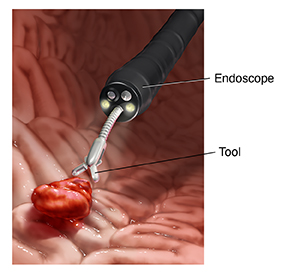Endoscopic Exam for Cancer
How is cancer diagnosed?
There isn't 1 test alone that can accurately diagnose cancer. A full medical history and physical exam along with diagnostic testing is often needed.
Many tests and procedures are used to find out if a person has cancer. They include imaging, lab tests (such as blood tests for tumor markers), tumor biopsy, endoscopic exam, surgery, and genetic testing. Testing can to confirm or rule out cancer, watch cancer growth, plan treatment, and see if treatment is working. In some cases, repeat testing is needed when your condition has changed. Repeat testing is sometimes needed.
Endoscopic exams are used to look inside the body using a thin, tube-like device called an endoscope.
What are some types of endoscopic exams?

An endoscope is a small, flexible tube with a light and a lens or tiny video camera on the end. It can look into the esophagus, stomach, duodenum, colon, rectum, or other organs. It can also take tissue from the body for testing (biopsy). Or it can take color photos. Different types of endoscopes that are often used to diagnose cancer include:
-
Colonoscopy. This procedure allows the health care provider to see the entire length of the large intestine (colon). It can often help find abnormal growths, inflamed tissue, ulcers, and bleeding. A long, flexible, lighted tube (colonoscope) is put in through the rectum up into the colon. The provider can see the lining of the colon, remove tissue for further exam, and possibly treat some problems that are found.
-
ERCP (endoscopic retrograde cholangiopancreatography). With an ERCP the provider can diagnose and treat problems in the liver, gallbladder, bile and pancreatic ducts, and pancreas. The procedure combines X-rays with an endoscope. The scope is guided through the person's mouth and throat. Then it goes through the esophagus, stomach, and the first part of the small intestine (the duodenum). The provider can check the inside of these organs. A tube is then passed through the scope and a contrast material is injected into the pancreatic duct. X-rays can show narrowed areas or blockages in the bile and pancreatic ducts. The X-ray imaging is called fluoroscopy.
-
EGD or upper endoscopy (esophagogastroduodenoscopy). This procedure lets the provider look at the inside of the esophagus, stomach, and duodenum. The endoscope is guided into the mouth and throat. Then it goes into the esophagus, stomach, and duodenum. Tiny tools can be inserted through the scope to remove a tissue sample for biopsy, if needed.
-
Sigmoidoscopy. This procedure lets the provider see the inside of the rectum and a part of the large intestine. It can help identify the causes of diarrhea, stomach pain, constipation, abnormal growths, and bleeding. It uses a short, flexible, lighted tube called a sigmoidoscope. The scope is put into the intestine through the rectum. It blows air into the intestine to inflate it and make seeing the inside easier.
-
Bronchoscopy. This procedure lets the provider see the inside of the windpipe (trachea) and large airways leading into the lungs (bronchi). A short, flexible, lighted tube (bronchoscope) is inserted through the mouth or nose. Tissue samples may be removed through the bronchoscope for exam later in the lab.
-
Cystoscopy. For this exam, a tube with a viewing device (cystoscope) is inserted through the urethra. It lets the provider check the bladder and urethra for structural problems or blockages, such as tumors or stones. Samples of the bladder tissue may be removed through the cystoscope for exam later in the lab.
-
Laryngoscopy. For this exam, the provider uses a thin, flexible tube (laryngoscope) to see the larynx. This includes the back of your throat and voice box (vocal cords).
Your provider can tell you more about a specific test. This includes where it will be done, how to get ready, and what recovery will be like.